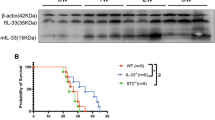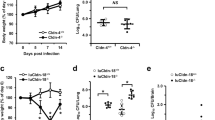Abstract
Cryptococcus neoformans (C. neoformans) is an important opportunistic fungal pathogen for pulmonary cryptococcosis. Previously, we demonstrated that CD146 mediated the adhesion of C. neoformans to the airway epithelium. CD146 is more than an adhesion molecule. In the present study, we aimed to explore the roles of CD146 in the inflammatory response in pulmonary cryptococcosis. CD146 was decreased in lung tissues from patients with pulmonary cryptococcosis. Similarly, C. neoformans reduced pulmonary CD146 expression in mice following intratracheal inoculation. To explore the pathological roles of CD146 reduction in pulmonary cryptococcosis, CD146 knockout (KO) mice were inoculated with C. neoformans via intratracheal instillation. CD146 deficiency aggravated C. neoformans infection, as evidenced by a shortened survival time and increased fungal burdens in the lung. Inflammatory type 2 cytokines (IL-4, IL-5, and TNF-α) and alternatively activated macrophages were increased in the pulmonary tissues of CD146 KO-infected mice. CD146 is expressed in immune cells (macrophages, etc.) and nonimmune cells, i.e., epithelial cells and endothelial cells. Bone marrow chimeric mice were established and infected with C. neoformans. CD146 deficiency in immune cells but not in nonimmune cells increased fungal burdens in the lung. Mechanistically, upon C. neoformans challenge, CD146 KO macrophages produced more neutrophil chemokine KC and inflammatory cytokine TNF-α. Meanwhile, CD146 KO macrophages decreased the fungicidity and production of reactive oxygen species. Collectively, C. neoformans infection decreased CD146 in pulmonary tissues, leading to inflammatory type 2 responses, while CD146 deficiency worsened pulmonary cryptococcosis.








Similar content being viewed by others
Data availability
The datasets used and/or analyzed during the present study are available from the corresponding author on reasonable request.
References
Setianingrum F, Rautemaa-Richardson R, Denning DW (2019) Pulmonary cryptococcosis: a review of pathobiology and clinical aspects. Med Mycol 57(2):133–150
Davis MJ, Tsang TM, Qiu Y, Dayrit JK, Freij JB, Huffnagle GB et al (2013) Macrophage M1/M2 polarization dynamically adapts to changes in cytokine microenvironments in Cryptococcus neoformans infection. MBio 4(3):e00264-e313
Deerhake ME, Reyes EY, Xu-Vanpala S, Shinohara ML (2021) Single-cell transcriptional heterogeneity of neutrophils during acute pulmonary Cryptococcus neoformans infection. Front Immunol 12:670574
Sun D, Zhang M, Liu G, Wu H, Zhu X, Zhou H et al (2016) Real-time imaging of interactions of neutrophils with Cryptococcus neoformans demonstrates a crucial role of complement C5a–C5aR signaling. Infect Immun 84(1):216–229
Mednick AJ, Feldmesser M, Rivera J, Casadevall A (2003) Neutropenia alters lung cytokine production in mice and reduces their susceptibility to pulmonary cryptococcosis. Eur J Immunol 33(6):1744–1753
Sun Z, Ji N, Jiang J, Tao Y, Zhang E, Yang X et al (2020) Fine particulate matter (PM2.5) promotes CD146 expression in alveolar epithelial cells and Cryptococcus neoformans pulmonary infection. Front Microbiol 11:525976
Wang Z, Yan X (2013) CD146, a multifunctional molecule beyond adhesion. Cancer Lett 330(2):150–162
Bardin N, Blot-Chabaud M, Despoix N, Kebir A, Harhouri K, Arsanto JP et al (2009) CD146 and its soluble form regulate monocyte transendothelial migration. Arterioscler Thromb Vasc Biol 29(5):746–753
Luo Y, Duan H, Qian Y, Feng L, Wu Z, Wang F et al (2017) Macrophagic CD146 promotes foam cell formation and retention during atherosclerosis. Cell Res 27(3):352–372
Blin MG, Bachelier R, Fallague K, Moussouni K, Aurrand-Lions M, Fernandez S et al (2019) CD146 deficiency promotes plaque formation in a mouse model of atherosclerosis by enhancing RANTES secretion and leukocyte recruitment. J Mol Cell Cardiol 130:76–87
Duan H, Jing L, Xiang J, Ju C, Wu Z, Liu J et al (2022) CD146 associates with Gp130 to control a macrophage pro-inflammatory program that regulates the metabolic response to obesity. Adv Sci (Weinh) 9(13):e2103719
Zhang B, Li L, Feng L, Zhang Y, Zeng X, Feng J et al (2009) Elevated levels of soluble and neutrophil CD146 in active systemic vasculitis. Lab Med 40(6):351–356
Sun Z, Ji N, Jiang J, Tao Y, Zhang E, Yang X et al (2020) Fine particulate matter (PM(2).(5)) promotes CD146 expression in alveolar epithelial cells and Cryptococcus neoformans pulmonary infection. Front Microbiol 11:525976
Surawut S, Ondee T, Taratummarat S, Palaga T, Pisitkun P, Chindamporn A et al (2017) The role of macrophages in the susceptibility of Fc gamma receptor IIb deficient mice to Cryptococcus neoformans. Sci Rep 7:40006
Flaczyk A, Duerr CU, Shourian M, Lafferty EI, Fritz JH, Qureshi ST (2013) IL-33 signaling regulates innate and adaptive immunity to Cryptococcus neoformans. J Immunol 191(5):2503–2513
Benonisson H, Altıntaş I, Sluijter M, Verploegen S, Labrijn AF, Schuurhuis DH et al (2019) CD3-bispecific antibody therapy turns solid tumors into inflammatory sites but does not install protective memory. Mol Cancer Ther 18(2):312–322
Dai X, Mao C, Lan X, Chen H, Li M, Bai J et al (2017) Acute Penicillium marneffei infection stimulates host M1/M2a macrophages polarization in BALB/C mice. BMC Microbiol 17(1):177
Liu Y, Yuan Q, Zhang X, Chen Z, Jia X, Wang M et al (2023) Fine particulate matter (PM2.5) induces inhibitory memory alveolar macrophages through the AhR/IL-33 pathway. Cell Immunol 386:104694
Osterholzer JJ, Chen GH, Olszewski MA, Zhang YM, Curtis JL, Huffnagle GB et al (2011) Chemokine receptor 2-mediated accumulation of fungicidal exudate macrophages in mice that clear cryptococcal lung infection. Am J Pathol 178(1):198–211
Huang HR, Li F, Han H, Xu X, Li N, Wang S et al (2018) Dectin-3 recognizes glucuronoxylomannan of Cryptococcus neoformans serotype AD and Cryptococcus gattii serotype B to initiate host defense against cryptococcosis. Front Immunol 9:1781
Nakamura Y, Sato K, Yamamoto H, Matsumura K, Matsumoto I, Nomura T et al (2015) Dectin-2 deficiency promotes Th2 response and mucin production in the lungs after pulmonary infection with Cryptococcus neoformans. Infect Immun 83(2):671–681
Piehler D, Stenzel W, Grahnert A, Held J, Richter L, Kohler G et al (2011) Eosinophils contribute to IL-4 production and shape the T-helper cytokine profile and inflammatory response in pulmonary cryptococcosis. Am J Pathol 179(2):733–744
Lloyd CM, Snelgrove RJ (2018) Type 2 immunity: expanding our view. Sci Immunol 3(25):eaat1604
Zhao X, Guo Y, Jiang C, Chang Q, Zhang S, Luo T et al (2017) JNK1 negatively controls antifungal innate immunity by suppressing CD23 expression. Nat Med 23(3):337–346
Ishizuka S, Yokoyama R, Sato K, Shiroma R, Nakahira A, Yamamoto H et al (2020) Effect of CARD9 deficiency on neutrophil-mediated host defense against pulmonary infection with Streptococcus pneumoniae. Infect Immun 89(1):e00305-e320
Guillot L, Carroll SF, Homer R, Qureshi ST (2008) Enhanced innate immune responsiveness to pulmonary Cryptococcus neoformans infection is associated with resistance to progressive infection. Infect Immun 76(10):4745–4756
Leopold Wager CM, Wormley FL Jr (2014) Classical versus alternative macrophage activation: the Ying and the Yang in host defense against pulmonary fungal infections. Mucosal Immunol 7(5):1023–1035
Qian YN, Luo YT, Duan HX, Feng LQ, Bi Q, Wang YJ et al (2014) Adhesion molecule CD146 and its soluble form correlate well with carotid atherosclerosis and plaque instability. CNS Neurosci Ther 20(5):438–445
Kechichian TB, Shea J, Del Poeta M (2007) Depletion of alveolar macrophages decreases the dissemination of a glucosylceramide-deficient mutant of Cryptococcus neoformans in immunodeficient mice. Infect Immun 75(10):4792–4798
Nelson BN, Daugherty CS, Sharp RR, Booth JL, Patel VI, Metcalf JP et al (2022) Protective interaction of human phagocytic APC subsets with Cryptococcus neoformans induces genes associated with metabolism and antigen presentation. Front Immunol 13:1054477
Coelho C, Souza AC, Derengowski Lda S, de Leon-Rodriguez C, Wang B, Leon-Rivera R et al (2015) Macrophage mitochondrial and stress response to ingestion of Cryptococcus neoformans. J Immunol 194(5):2345–2357
de Kruijff IE, Timmermans AM, den Bakker MA, Trapman-Jansen A, Foekens R, Meijer-Van Gelder ME et al (2018) The prevalence of CD146 expression in breast cancer subtypes and its relation to outcome. Cancers (Basel) 10(5):134
Liao J, Fu Q, Chen W, Li J, Zhang W, Zhang H et al (2020) Plasma soluble CD146 as a potential diagnostic marker of acute rejection in kidney transplantation. Front Med (Lausanne) 7:531999
Ito T, Tamura N, Okuda S, Tada K, Matsushita M, Yamaji K et al (2017) Elevated serum levels of soluble CD146 in patients with systemic sclerosis. Clin Rheumatol 36(1):119–124
Sun Z, Ji N, Ma Q, Zhu R, Chen Z, Wang Z et al (2020) Epithelial-mesenchymal transition in asthma airway remodeling is regulated by the IL-33/CD146 axis. Front Immunol 11:1598
Misharin AV, Morales-Nebreda L, Mutlu GM, Budinger GR, Perlman H (2013) Flow cytometric analysis of macrophages and dendritic cell subsets in the mouse lung. Am J Respir Cell Mol Biol 49(4):503–510
Rose CE Jr, Lannigan JA, Kim P, Lee JJ, Fu SM, Sung SS (2010) Murine lung eosinophil activation and chemokine production in allergic airway inflammation. Cell Mol Immunol 7(5):361–374
Funding
This research was supported by the National Natural Science Foundation of China (82171738, 81671563), the Jiangsu Provincial Commission of Health and Family Planning (Q2017001), and the Shenzhen Science and Technology Program (JCYJ20210324115607021).
Author information
Authors and Affiliations
Contributions
Conceptualization, XY, MH, YB, NJ, and MZ; formal analysis, ZW, WL, JJ, and MZ; funding acquisition, YB and MZ; investigation, WL and HH; methodology, ZW, WL, HH, JJ, CY, XZ, QY, and XY; project administration, MZ; resources, HH and YB; supervision, MZ; validation, ZW; writing—original draft, ZW; writing—review and editing, YB, NJ, and MZ.
Corresponding authors
Ethics declarations
Conflict of interest
The authors have no conflicts of interest to declare.
Additional information
Edited by Christian Bogdan.
Publisher's Note
Springer Nature remains neutral with regard to jurisdictional claims in published maps and institutional affiliations.
Supplementary Information
Below is the link to the electronic supplementary material.
430_2023_780_MOESM1_ESM.tif
Flow cytometry gating strategy for cells in BALF. Flow cytometry shows the gating strategy of total cells (R1), leukocytes (R2), neutrophils (R3 gate), and macrophages (R4) from BALF (TIF 2170 KB)
430_2023_780_MOESM2_ESM.tif
CD146 deficiency promoted pulmonary inflammation and M2 polarization after challenge with heat-killed (HK) H99 cells. WT and CD146-/- mice were intratracheally infected with 1*104 HK C. neoformans H99 and sacrificed 2 weeks post infection. (A–B) KC and TNF-α in the lung homogenates were measured with ELISA. (C–E) iNOS and Arg1 in the lung were determined with qPCR. *, p<0.05; **, p<0.01; ***, P<0.001; ****, p<0.0001; ns, not significant (TIF 2170 KB)
430_2023_780_MOESM3_ESM.tif
The efficiency of differentiation of BMDMs. The purity of macrophages from cultured BMDMs was gated by CD45+F4/80+ (TIF 1100 KB)
430_2023_780_MOESM4_ESM.tif
Comparative study of some molecules in naïve WT vs CD146 mice. (A-E) IL-4, IL-5, IL-13, IFN-γ, and TNF-α in the lung tissues were measured by qPCR. (F-G) iNOS and Arg1 in lung tissue were measured by qPCR. *, ns, not significant (TIF 1858 KB)
430_2023_780_MOESM5_ESM.tif
Control stains of mouse lung tissue samples. Immunohistochemistry was performed without anti-CD146 and with secondary antibody alone in the tissue samples from mice without or with C. neoformans infection for 3 weeks. Scale bar, 50 μm (TIF 8072 KB)
Rights and permissions
Springer Nature or its licensor (e.g. a society or other partner) holds exclusive rights to this article under a publishing agreement with the author(s) or other rightsholder(s); author self-archiving of the accepted manuscript version of this article is solely governed by the terms of such publishing agreement and applicable law.
About this article
Cite this article
Wang, Z., Liu, W., Hu, H. et al. CD146 deficiency promotes inflammatory type 2 responses in pulmonary cryptococcosis. Med Microbiol Immunol 212, 391–405 (2023). https://doi.org/10.1007/s00430-023-00780-x
Received:
Accepted:
Published:
Issue Date:
DOI: https://doi.org/10.1007/s00430-023-00780-x




